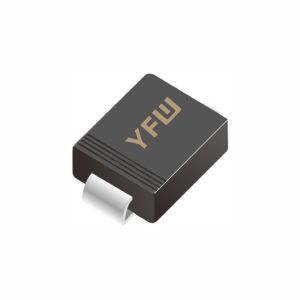A power diode is a two-terminal semiconductor device based on a PN junction, engineered to handle high voltages (up to thousands of volts) and currents (ranging from hundreds to thousands of amps) . Unlike signal diodes, power diodes feature a robust structure with a heavily doped P+ layer, a lightly doped N- drift region, and an N+ substrate. This design allows them to efficiently conduct current in the forward direction while blocking reverse voltage effectively . Key characteristics include low forward voltage drop (typically 0.8–1.2 V), fast recovery times, and high-temperature stability, making them ideal for demanding environments such as industrial converters, renewable energy systems, and motor drives .
The dynamic behavior of power diodes refers to their transient response during switching between forward conduction and reverse blocking states. These processes are critical for understanding power losses and system efficiency.
When transitioning from zero bias to forward bias, the power diode exhibits a forward recovery time (t_fr). Initially, the forward voltage drop experiences an overshoot (U_fp), which gradually stabilizes to the steady-state value (e.g., 2 V) as minority carriers accumulate in the drift region . This delay is attributed to the inductance of the device and external circuitry, as well as the time required for the conductance modulation effect to fully activate. A shorter t_fr minimizes switching losses and ensures smooth current flow in high-frequency applications .
The reverse recovery process is more complex and directly impacts device reliability. When the diode switches from forward conduction to reverse bias:
Delay Time (t_d): The forward current (I_F) decays to zero, but stored minority carriers in the PN junction sustain a reverse current (I_R) .
Current Fall Time (t_f): The reverse current peaks at I_RP and then decreases as carriers are swept out or recombine. This phase generates a voltage overshoot (U_RP) due to parasitic inductance in the circuit .
Reverse Recovery Time (t_rr = t_d + t_f): The total time for the diode to regain full blocking capability. A lower t_rr is desirable for high-frequency operations to reduce energy dissipation and electromagnetic interference (EMI) .
The softness factor (S_r = t_f / t_d) characterizes the recovery behavior. A higher S_r indicates a smoother transition, reducing voltage spikes and stress on the diode .
The dynamic waveforms of power diodes are illustrated in Figure 1 (for reference). During forward recovery, the voltage overshoot (U_fp) and current lag are evident, while reverse recovery shows the I_RP spike and U_RP overshoot. These waveforms highlight the importance of selecting diodes with optimized recovery characteristics for specific applications. YFW’s fast recovery diodes (FRDs) and Schottky barrier diodes (SBDs) are designed to minimize t_rr and U_RP, ensuring efficient and stable operation in switching circuits .
Power diodes are indispensable in power electronics, and their dynamic behavior directly influences system performance. By understanding the definition and waveform characteristics of these devices, engineers can optimize circuit design for efficiency and reliability. YFW’s commitment to innovation ensures that our power diodes, including FRDs and SBDs, deliver industry-leading performance in reverse recovery, forward voltage drop, and thermal management. For detailed specifications and applications, visit
www.yfwdiode.com.
This article is brought to you by YFW, a trusted name in semiconductor solutions
